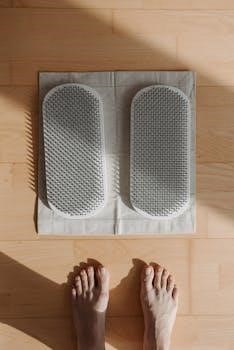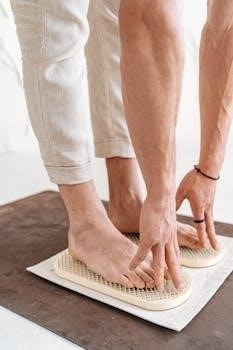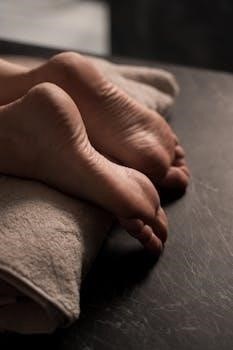Foot massage is a therapeutic practice involving manipulating the feet
to promote relaxation and stress relief. Regular foot massage improves
circulation, stimulates muscles, reduces tension, and eases pain. It
offers physical and mental benefits, enhancing overall well-being.

Benefits of Foot Massage
Foot massages offer numerous physical and mental benefits. They promote
relaxation, reduce stress, and improve circulation. Regular foot
massage can also alleviate pain, boost immunity, and enhance sleep
quality. These techniques contribute to holistic well-being and comfort
in daily life;
Promotes Relaxation and Stress Reduction
Foot massage is a therapeutic practice that significantly promotes
relaxation and reduces stress. By stimulating key pressure points on
the feet, this technique triggers the release of endorphins, the body’s
natural mood elevators. Consequently, feelings of tension and
apprehension often give way to a sense of calm.
The psychological benefits extend beyond just physical relief. By
reducing stress, enhancing mental well-being, and improving sleep
quality, foot massages contribute significantly to overall health and
happiness. This is largely due to the application of pressure on
specific reflex points on the feet.
Stimulating these points releases tension and promotes relaxation
throughout the body, leading to reduced physical and emotional
discomfort. Incorporating regular foot massages into a routine can be
empowering, making daily life more comfortable and adding value to a
pain management plan.
Improves Blood Circulation
One of the primary health benefits of foot massage is enhanced blood
flow. Poor circulation can lead to various health problems, including
fatigue, muscle cramps, and even cardiovascular issues. Foot massage
stimulates blood vessels in the feet and lower legs, promoting better
circulation throughout the body.
This improved blood flow helps deliver oxygen and nutrients to cells
more efficiently, aiding in tissue repair and overall health. Regular
foot massage can be particularly beneficial for individuals who spend
long periods standing or sitting, as it counteracts the effects of
gravity and inactivity on blood circulation.
The warmth generated during the massage further contributes to vasodilation,
enhancing blood flow. By incorporating foot massage into a wellness
routine, individuals can proactively improve their circulation and
support their overall cardiovascular health.
Pain Relief and Management
Foot massage is a common alternative treatment to relieve pain. It
is empowering for those on a pain management journey, adding value to
the treatment plan and making daily life more comfortable. Regular
sessions can reduce discomfort from conditions like plantar fasciitis
by loosening tight muscles and improving circulation.
Massaging the feet triggers the release of endorphins, natural pain
relievers in the body, alleviating discomfort. Focusing on pressure
points during the massage can address specific areas of pain, providing
targeted relief. This technique is particularly effective for managing
chronic foot pain and reducing reliance on medication;
The soothing nature of foot massage also helps reduce muscle tension,
contributing to pain reduction. By incorporating foot massage into a
daily or weekly routine, individuals can proactively manage pain and
improve their quality of life. Communication with a massage therapist
is essential to adjust pressure and technique as needed.
Boosts Immunity
Foot massage, beyond its relaxing benefits, can significantly boost
the immune system. By activating blood circulation, foot massage helps
distribute immune cells more effectively throughout the body. This
enhanced circulation allows immune cells to reach areas where they are
needed, improving the body’s ability to fight off infections.
The reduction of stress through foot massage also plays a crucial role
in boosting immunity. Stress suppresses the immune system, making the
body more susceptible to illness. By alleviating stress, foot massage
helps restore the immune system’s optimal function, enhancing its
ability to defend against pathogens.
Moreover, foot massage promotes lymphatic drainage, which is essential
for removing toxins and waste products from the body. A healthy
lymphatic system supports a robust immune response. Regularly
incorporating foot massage into a wellness routine can contribute to a
stronger, more resilient immune system, promoting overall health and
well-being.
Improves Sleep Quality
Foot massage can significantly improve sleep quality by promoting
relaxation and reducing stress, which are common disruptors of sleep.
The soothing effect of foot massage helps calm the nervous system,
making it easier to fall asleep and stay asleep throughout the night.
Stimulating pressure points on the feet can release tension and promote
a sense of calm, conducive to restful sleep.
Regular foot massage before bedtime can regulate blood flow, easing
aches and pains that might otherwise interfere with sleep. The
increased circulation helps relax muscles and alleviate discomfort,
creating a more comfortable state for sleep. Moreover, foot massage
promotes the release of endorphins, which have mood-boosting effects
and can further enhance relaxation.
By addressing both physical and mental factors that contribute to poor
sleep, foot massage offers a natural and effective way to improve
sleep quality. Incorporating this practice into a nightly routine can
lead to better sleep patterns, increased energy levels, and improved
overall well-being.

Foot Massage Techniques
Explore various foot massage techniques for relaxation, improved
circulation, and pain relief. Learn simple methods to perform at home,
focusing on pressure points and using lotions or oils for enhanced
benefits.
Basic Foot Massage Techniques at Home
You don’t always need a massage therapist to enjoy the benefits of a foot massage. Begin by soaking your feet in warm water to relax the muscles. Apply lotion or oil to reduce friction. Sit comfortably and gently rub lotion into your foot. Massage the whole foot, including the heel and toes.
Use your thumbs to make small, circular motions on the sole of your foot. Focus on areas that feel tense or sore. Gently pull, twist, and rub each toe between your thumb and index finger to alleviate tension. A foot roller is a low-tech device that can provide quick foot massages.
Pour some skin lotion or oil into your hand. Rub it gently into your foot and massage your whole foot, including the ankle. Regular foot massages can improve circulation, reduce tension, and ease pain. It also gives you a chance to examine your feet and address any problems.
Using Lotion or Oil
Applying lotion or oil is essential for a comfortable and effective foot massage. Lotion reduces friction, allowing your hands to glide smoothly over the skin. Choose a lotion with a pleasant scent to enhance relaxation. Pour a small amount into your hand, rub it, and apply it to your foot.
Massage the lotion into your foot using gentle, circular motions. Ensure even coverage, paying attention to the soles, heels, and toes. Reapply as needed to maintain lubrication throughout the massage. Certain essential oils can enhance the massage’s therapeutic benefits. Lavender promotes relaxation, while peppermint soothes tired muscles.
Warm the oil slightly before applying it to your foot for added comfort. Be cautious not to use too much oil, as it can make the foot slippery and difficult to grip. Using lotion or oil not only makes the massage more comfortable but also nourishes the skin.
Focusing on Pressure Points
Focusing on pressure points during a foot massage enhances its therapeutic
effects. These points correspond to different body parts and organs,
stimulating them to promote healing. Apply firm, steady pressure to each
point, using your thumb or fingertips. Hold the pressure for a few seconds
before releasing.
Pay attention to your body’s response, adjusting the pressure as needed.
Common pressure points include the ball of the foot for lung health, the
arch for digestion, and the heel for lower back pain; Massaging these
points can relieve tension, improve circulation, and promote overall
well-being.
Use circular motions or gentle kneading to stimulate the pressure points
effectively. If you experience any pain or discomfort, reduce the pressure
or move on to another area. Regularly massaging pressure points can lead to
reduced pain, improved sleep, and enhanced emotional well-being.
Toe Massage
Toe massage is a vital part of a comprehensive foot massage, often
overlooked but incredibly beneficial. Gently pull, twist, and rub each toe
between your thumb and index finger to promote relaxation and alleviate
tension. This technique targets specific pressure points, stimulating nerves
and improving circulation to the toes and surrounding areas.
Start by holding each toe individually, gently rotating it in a circular
motion. Then, use your thumb and index finger to massage the entire length
of the toe, paying attention to any areas of tension or discomfort. Apply
a small amount of lotion or oil to reduce friction and enhance the
massage experience.
Massaging the toes can help relieve headaches, sinus congestion, and neck
pain, as these areas are connected through reflex points. Regular toe
massage can lead to reduced stress, improved sleep quality, and a greater
sense of overall well-being. Don’t underestimate the power of a simple toe
massage to rejuvenate your feet and body.

Foot Reflexology
Foot reflexology is a therapeutic technique based on the principle that
specific points on the feet correspond to different organs and systems in
the body. By applying pressure to these reflex points, practitioners aim to
promote healing, relieve pain, and restore balance throughout the body.
Reflexology differs from a regular foot massage as it focuses on these
specific points rather than general muscle relaxation.
During a reflexology session, a trained therapist will use their thumbs,
fingers, and hands to apply targeted pressure to various areas of your
feet. This stimulation is believed to trigger the release of endorphins,
the body’s natural painkillers, and improve circulation. Many people
experience a sense of deep relaxation and well-being during and after a
reflexology treatment.
Reflexology has been used for centuries to address a wide range of health
conditions, including stress, anxiety, headaches, digestive issues, and
chronic pain. While more research is needed to fully understand its
mechanisms, many individuals find it to be a valuable complementary therapy
for promoting overall health and wellness.

Precautions and Considerations
While foot massage offers numerous benefits, it’s essential to be aware of
certain precautions and considerations. Individuals with specific health
conditions should consult their healthcare provider before receiving or
performing foot massage. This includes people with diabetes, neuropathy,
vascular issues, or open wounds on their feet.
Pregnant women should also exercise caution and seek guidance from their
doctor or a qualified massage therapist experienced in prenatal massage.
Certain pressure points on the feet are believed to stimulate uterine
contractions, so it’s crucial to avoid these areas during pregnancy.
If you experience any pain or discomfort during a foot massage, it’s
important to communicate with your massage therapist and adjust the pressure
or technique accordingly. Avoid applying excessive pressure, especially on
sensitive areas or bony prominences.
Individuals with skin infections, such as athlete’s foot or plantar warts,
should refrain from receiving foot massage to prevent the spread of
infection. Similarly, those with blood clots or deep vein thrombosis should
avoid massage on the affected leg to minimize the risk of dislodging the
clot. Always prioritize safety and seek professional advice when in doubt.

No Responses